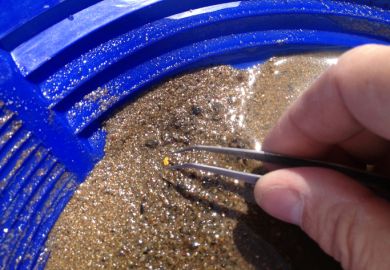As in baseball, a reviewer must "call it as he sees it". My call is that this book is pretty awful. However, reviewers sometimes nod off, missing qualities in a book with cover plaudits by Kurt Vonnegut, V.
S. Ramachandran, Floyd Bloom, James Watson and Howard Gardner. If I am wrong and Gardner is right about "a clear, readable, synoptic account of current knowledge in human creativity", then here are some maxims for emulating Nancy Andreasen's way of communicating science.
* You must not be underestimated . In the preface, say how in kindergarten you were "IQ-tested and declared a 'genius'". Then emphasise medical and scientific credentials by saying how "most people think of me as a well-known neuroscientist", but "people also know me as a dedicated physician-scientist... who has devoted much of my life to caring for people"
* Don't hide your talents . Stress that your PhD is "not in biochemistry or biology, as many assume, but instead in Renaissance English literature", making you "an established scholar in the field", and for five years "a professor of English literature at several different universities". Do not worry about using phrases such as "a somewhat unique perspective"
* Lay it on thick . Some puddings cannot be over-egged, so do say: "In my mind I walk the streets of Elizabethan England or Renaissance Florence as readily as I walk the corridors of hospitals or scientific laboratories. And I read Shakespeare and Sophocles as readily as I read brain scans or Science magazine." Ignore poststructuralist stuff about the death of the author -make clear upfront who you are
* Don't forget the common touch . Add some cutesy McDonald's-speak. After a long paragraph containing only questions, purr and say: "These are grand questions. I'll be your guide in trying to answer them. I am thrilled that I am able to do it." But, hang on, this isn't just for fun. Also use some Nasa-speak. "I'll be at your side as we embark on a wonderful exploratory adventure... Our mission is especially exciting and novel because... we are exploring the neuroscience of creativity, a difficult mission that few have as yet attempted." A small step for one Renaissance womanI
* Let the reader know your low expectations of them . Ask direct questions and do not expect answers. "What is human thought? Have you ever thought to ask yourself that question? Probably not." If they have, this book is not for them anyway. Also acknowledge your readers' anxieties. Those following your advice and taking the first painful, creative steps in using a computer for writing will be reassured to hear: "You probably haven't done this sort of thing since you took freshman composition in high school or college"
* Don't expect readers to know anything . Just help them out. Few will have heard of Prospero, but it helps to call him "the conceptual ancestor of... Dumbledore in Harry Potter ". Do, though, assume they have seen the films Shine, A Beautiful Mind and Lord of the Rings . And of course it is true everywhere that "as schoolchildren, we all learned about how Eli Whitney's invention of the cotton gin transformed the economy of the South". In North London, we talked of little else
* Never resist a cliché . Clichés are a mark of good writing. Referring to "Mother Nature" is good science (although if Francis Galton had done so it would have been "a vivid snapshot of an era in which prejudices abounded and the concept of 'political correctness' did not exist")
* Include a graph that is wrong . Use some technical terms - "continuous dimension" and "discrete category" - to argue for a separate category of extremely gifted individuals. The graph showing this should have no separate categories, being continuous and skewed the wrong way, with a long tail of extremely uncreative individuals. Readers do not look at graphs or brain scans, which are merely corroborative detail giving scientific verisimilitude
* Feel free to speculate . Quoting Havelock Ellis's 1926 study of the British Dictionary of National Biography shows scholarship, and readers will marvel when you speculate that Bertrand Russell "may well have been one of Ellis's... 'men of genius'". Only pedants will object that in 1926 Russell was alive, whereas the DNB includes only the dead
* Rhetorical questions never have answers . When talking about the Parthenon, just ask: "How did they ever chisel those huge columns?" Few readers expect such questions to have answers, and none will type "Parthenon" into amazon.com and find Manolis Korres's fascinating book The Stones of the Parthenon
* Scientific history is bunkum . No one cares about the history of science, least of all scientists. The year 1926 was centuries ago, and therefore "pre-epidemiological" - for John Snow removed the handle of the Broad Street pump only in 1854 - and "preneuroscience" - for Paul Flechsig described association cortex, the cornerstone of your theory, only in 1900.
* Talking to celebrities is research . Meeting playwright Neil Simon by chance on a plane is definitely research. Readers will not notice the inconsistency if elsewhere researchers are criticised for relying "primarily on anecdotes"
* You need to include some ideas , although ideas actually matter very little -at least other people's, which are mostly wrong. Scientific ideas are also hard work, so pad them with rambling accounts of Renaissance Italy, uninspired thoughts on human evolution and brief case studies of creativity in Coleridge, Mozart, Tchaikovsky, Poincaré, Kekulé and Stephen Spender (who can be called "formerly British Poet Laureate", even if he was not, and the laureateship is of England)
* Show how science is based in evidence . Include a few PC comments on gender equality and then state: "I cannot believe that women are innately less creative than men." That makes the scientific method perfectly clear
* Confront the difficult . Devote nearly a whole chapter to basic neuroanatomy and neurophysiology, fetishising brain complexity (a trillion neurons, a quadrillion synapses) while making throwaway remarks about chaos theory, butterflies and non-linear systems - de rigueur for popular science. There is grandeur in this view of life
* Your own research is the best . Your own research is all anyone cares about. Describe a study of subjects lying in a darkened brain scanner at REST - "random episodic silent thought" - where activity is found not in sensory areas but in the "association cortex". From there to the promised explanation of "the neuroscience of genius" is a small step, as long as "possessors of extraordinary creativity are apparently blessed with brains that are more facile at creating free associations". Don't fret that this is pure speculation.
* Help to build a better world . Say how intelligence is unrelated to creativity -reassuring those readers - and have a chapter of folksy suggestions on "building better brains", "tips for teaching tots", and ways "to nurture the creative nature that we all share". Few among the book-buying classes think to "plan vacations that occasionally take you to great natural locations - to the ocean (or) the mountains"
* Ensure that the book cover is right . After your name, it must, must, must state in large letters "MD, PhD" - readers trust no one else
* Ask Kurt Vonnegut to do your blurb . If Vonnegut says: "Our leading authority on creativity reveals herself, with this splendid book, as one of the most valuably creative persons of our time", then few reviewers will dare to disagree. So it goes.
Chris McManus is professor of psychology and medical education, University College London.
The Creating Brain: The Neuroscience of Genius
Author - Nancy C. Andreasen
Publisher - Dana Press
Pages - 197
Price - £15.50
ISBN - 1 932594 07 8



